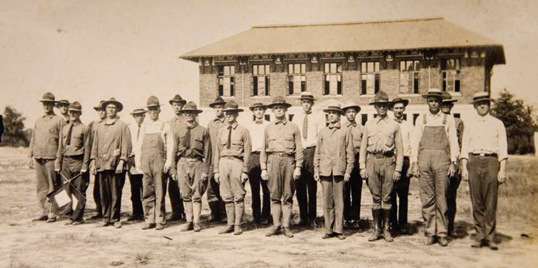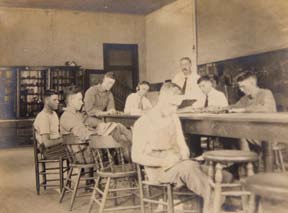|
A Centennial of Auburn Engineering:
|
||||||||||||
 |
| Mechanical engineering students stand in formation for cadet training in 1918. While courses in military tactics dominated student life in the 19th century, the retooling of Auburn as a land grant institution would add a new emphasis on ‘the agriculture and mechanic arts.’ |
A century ago – in the 1909 academic year – civil, electrical, mechanical, mining, telephone and architectural engineering were being taught at API, as Auburn was known from 1898 through 1960. Enrollments were on the rise and Broun Hall was enlarged to accommodate growth.
 |
| Professor Arthur St. Charles Dunstan in mid-career with a class of electrical engineering students. He would teach at Auburn for 51 years. |
As summer turned to fall and students returned to campus, the Orange and Blue claimed, “Despite the ravages of war, Auburn’s enrollment … promised to fall little short of last year’s.” The Army held an officer’s training camp for both students and graduates to prepare them “for appointment as officers to fill vacancies that may occur,” and almost 2,500 college men from around the nation entered the training program as America continued in its fifteenth month of war in June 1918.
While overall enrollment declined, engineering numbers increased because as a critical skill these students received deferments, “not granted to the individual, but as a measure for the Defense of the Nation.” In all, about 1,100 Auburn men served during the first year of the war, with more than 225 men enlisting directly out of the ranks of the student body. On Nov. 11, the allies signed an armistice with the Germans and at 11 a.m. hostilities ceased. They held celebrations in Auburn, as they did across the nation, as peace returned. After the December holidays, hundreds of new students enrolled for the winter and spring terms.
 |
| A civil engineering student reaches for an engineer’s scale; on the drafting table are a t-square, triangle and ink well – all of which outlasted typewriters in student life, but only by a few years. |
Overall enrollment in 1919 grew to almost 1,300 regular students and a record-breaking 676 freshmen, more than two-and-a-half times the number in 1918. The Army reorganized its campus ROTC companies into infantry, field artillery and engineering units and replaced the cadet grey uniforms with the army khaki of the doughboy. They trained “engineering students in the duties of the Corps of Engineers . . . so that the future wars will find a trained body of Engineer officers to assist in the formation of new armies.” Cadets took courses in the military aspects of engineering practices including “roads, railroads, bridges, maps and map making, fortifications, engineer’s organizations, river and harbor work, and demolitions.” The demolition course was “of particular interest” because it allowed students “to actually handle the paraphernalia of explosive works.”
The decade leading to 1920 was mainly prosperous for Auburn. Under the leadership of Thach, the College of Engineering came to prominence, leading some to accuse the president of favoring engineering at the expense others, something he always denied. Whether it was with bias or foresight, Thach oversaw the establishment and the first decade of growth of the College of Engineering. However, due to ill health, he retired in 1920 and soon died. Spright Dowell, an educator and administrator, took over the presidency but not Thach’s place in the hearts of alumni.
Engineering E-Mag is a service of the Samuel Ginn College of Engineering. This newsletter is distributed to alumni and friends throughout the year.
To read archived copies visit: http://www.eng.auburn.edu/.
To learn more about the Samuel Ginn College of Engineering, visit our Web site at:http://www.eng.auburn.edu/.
QUESTIONS about Engineering E-Mag may be directed to Michael Stone, Webmaster for the Samuel Ginn College of Engineering, at webmaster@eng.auburn.edu
Auburn University is an equal opportunity educational institution/employer.


